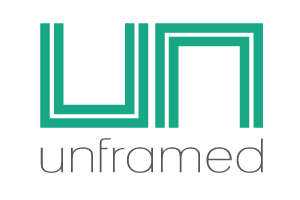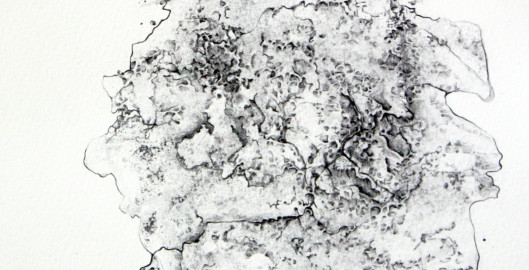08
Mar
Drawing as an experiment
- By Jean Wilkey
- One Comment
Drawing as an experiment in controlled chaos: an interview with Jenny Core
Jenny Core’s work explores the perimeters and the possibilities of mark-making. Her work is as once delicate and substantial, compelling and intimate. It draws you in close and you can loose yourself in it, spending time exploring its nuanced lines and shapes. Her approach to art-making is novel and is an exploration of the effects of the media itself on the outcome of the final work, in much the same way as Cai Guo Qiang’s [http://www.caiguoqiang.com/] gunpowder drawings are controlled experiments in art-making. She recently answered the following questions about her work from Jean Wilkey for Unframed.
Jenny, you mention that your work is about an investigation into the “potential and diversity” of drawing as a medium. You’re integrating the process of art making into the exploration of its potential in using actual objects or materials that disappear in the process. The method of creating is important to the finished drawing but we don’t get to see that process in the final work – only it’s remnants. Experimenting with the effects of the medium itself on the drawing is almost like a chemist experimenting with substances. This is a very conceptual approach to making art.
Jean Wilkey. Can you tell us why this approach interests you?
Jenny Core. Over the past 60 years, drawing has become more prominent in the art world as these sketches, lines and marks have come out of the privacy of the artist’s sketchbook’s and are available for the world to see. With more and more artists using drawing, I wanted to explore what drawing could be and investigate how we could define drawing as a medium. In my current research I believe drawing, in its broadest sense, is mark making. I am fascinated with the idea of drawing with objects instead of observing objects – concentrating more specifically on the act of drawing itself.
Drawing interests me as I love how unique the medium is. Creating a mark, which cannot be made by anyone else.
JW. What path have you followed to get where you are currently in your work? Tell us what you were doing before and how your work evolved into this approach.
JC. I have always used drawing but I used it more as a preparatory process instead of a final outcome. My drawings originally helped me realise short films and installations but the more my pencil hit the paper, the more interested I became with drawing itself.
JW. Please tell us a little about your influences and inspirations.
JC. What feeds my practice is ideas of play. I love all work that are experimental and process focused such as the works of artist Francis Alys. [http://www.francisalys.com/] I am inspired by people that transform mediums in an almost alchemic fashion, pushing the boundaries of their materials and making us see things differently, such as the works of artist Mary Griffiths. [http://marygriffiths.com/art/]
JW. Even though your focus is exploring the potential inherent in mark-making, the process and materials seem integral. Can you give us some specific examples of how you are using the materials in making the work for ‘Form’, and elaborate the “time led and performative” aspects of the work?
JC. My favourite part of creating my works is making objects to draw with. I love capturing the energy and essence of an object, giving its presence permanence on paper. I have created objects using frozen ink and water solution and allowed it to melt and spill over paper. Another process I have used is ink and bubble solution. I capture the bubbles on paper, which create energetic forms that I then manipulate with inks and pencils. The works shown in ‘Form’ have been realised by using graphite powder and water. When the water hits the graphite powder, it creates metallic forms. In a print style process, I press the paper into these objects, which results in a marbled marks that I then work into with graphite and watercolour.
JW. What excites you the most about working this way?
JC. What excites me the most about working this way is its contradictory process. It starts with chance and play. Creating objects and capturing them and having very little control over the outcome. To then drawing detailed lines and manipulating the marks. You could say I am trying to control the uncontrollable; creating order to chaos.
JW. Do you finish your pieces in one session or over many days or weeks? The work seems highly related. Does one piece evolve out of the other or are they discrete responses to what is happening with the materials?
JC. The works in ‘Form’ have been created using graphite powder and water solution. I create the solution and press the paper into it. One batch of solution can create up to five different pieces, which all show very similar shapes due to this print style process. I never ‘finish’ a piece in one sitting. I work on several at the same time. I prop them up in front on me as I work on one. I add detail to one piece and place in front of me and then select another piece to work on and so on. Weeks can pass until I have decided if it is the finished article.
JW. What do you want the viewer to take away from this work?
JC. Pareidolia (the phenomenon of searching for significance in imagery such as clouds etc) is the underlining theme in this series of work. I want the viewer to have their own experience with the work and see things no other can see.
JW. How long have you been making art and what do you think has helped your development the most?
JC. I have been making art professionally, outside of the institution, since 2009. However, I imagine this is the same for all artists, I have been creating since I could hold a pencil, my love for art grew from there. I feel my work has really developed over the past couple of years. There has not been one specific event that has shifted my way in working, just a long series of research, experimenting and collaborations.
JW. What does your typical workday in the studio look like and how often do you get to work on your art?
JC. I work on my artist practice full time, but a lot of my time goes into marketing my practice, applying for opportunities, finance and networking. On an average working week I get 2/3 solid working days of creating. This alters depending on commissions and deadlines. These are my favourite days!
JW. What is on the horizon; what do you dream of doing next?
JC. I am working on a project called The Drawing Project. This launched in February 2014 with an exhibition at Castlefield Gallery in Manchester (UK), funded by the CG Associates Scheme. The Drawing Project is a research project led by myself. The project has been created to investigate the current approach to drawing, considering specifically how artists define and use drawing in their practice. I want to expand on this project, creating opportunities for artists working in drawing and open up a platform for research and skills sharing alongside publications and touring exhibitions. I am currently looking in to funding for this. More info here: http://thedrawingprojectnorthwest.wordpress.com
JW. Is there anything you’d like to add?
JC. Thank you for selecting my work for your online gallery.



Submit a Comment